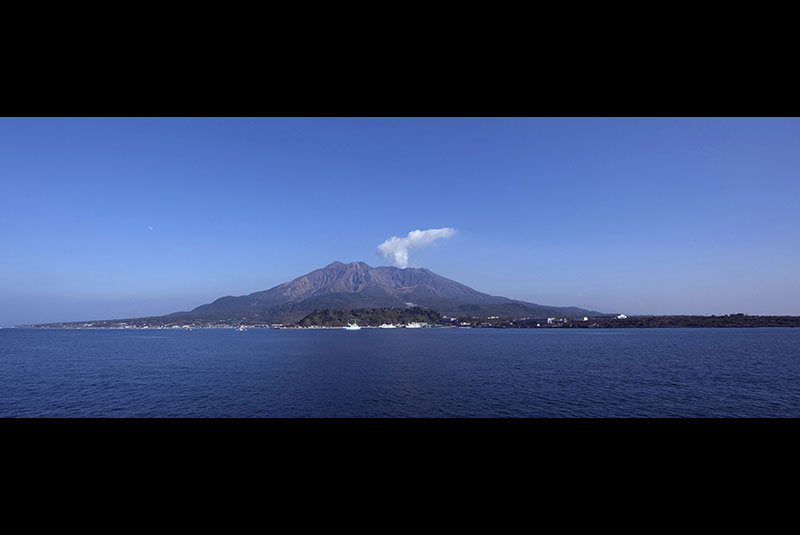Sakurajima: But where are the cherry blossoms?

The volcano dominates your first view of Sakurajima.
MANILA, Philippines - The blooming of the sakura or cherry blossom is always anticipated with celebratory joy, heralding the arrival of spring.
So what to make of Sakurajima – its two Kanji characters literally meaning “cherry blossom” and “island” – which defied expectations of an island carpeted by the petals of their national flower. Disappointingly, the area is devoid of any tree for which it is named, for it is one of the most active volcanic islands which still regularly emits harmless smoke daily. Sometimes, it even shoots clouds of ash and rocks into the sky, just to remind everyone of what it is capable of.
We had just disembarked at the familiar port of Kagoshima, on the southwestern tip of the Kyushu region of Japan, and were told we had to cross another body of water to finally reach our destination for the day. You see, Sakurajima is similar to our very own Taal Volcano in several ways, one of which is traversing through a secluded bay as the only access to the area.
The nautical passage was like clockwork, similar to how the Star Ferry between Hong Kong and Kowloon operates, though more leisurely, with mainly holidaymakers and backpackers instead of businessmen and office workers.
Curious, we joined a hyped-up queue to order bowls of their signature udon, a thick wheat flour noodle served with a simple soup. As per tradition, the 15-minute, 3.5-kilometer sail ends exactly when you’ve had the last slurp of the steaming hot broth. We noticed that the deeper we had reached our bowls for noodles, the more cosmopolitan Kagoshima faded away, while the lush landscape of Sakurajima slowly started to appear.
Sakurajima is one of the 16 Decade Volcanoes, which is a worldwide collection of the largest, most destructive volcanoes that can be observed and studied.
An estimated 5,000 people live in harmony within its ridges, amidst craggy rock formations and volcanic boulders, lined predominantly with black pine and pampas grass.
The origin of the name has multiple interpretations. One story narrates that a goddess called Konohama Sakuyahime blessed the expanse. Another claims it is in memory of their local dignitary named Sakurajima Tadanobu. A more plausible explanation could be that in the earlier days, cherry blossoms would be seen all around the mountains and hills – before the mount eradicated all life in its circumference.
We started at the Visitor Center, where we were audience to a captivating audio-visual presentation on the early life, destruction and rebuilding within the mountain’s general radius. We soon learned that a huge explosion over a century ago transformed the entire land mass, and even connected the isle to a peninsula.
Today, the towering peaks have been made part of a geopark, which is a UNESCO-designated term for sites of particular geological importance.
We proceeded with our hike, taking several pathways around the vicinity of the majestic, imposing volcano, filled with informative signage to guide our walk. What caught our eye was one that warned tourists not to take home any of the pebbles – basically declaring what’s from the island, stays on the island.
Under the near-scorching sun, we took refuge at the Yogan Nagisa Park Foot Spa, one of the longest in Japan that stretches to a length of 100 meters, and dipped our toes in naturally heated spa waters. Refreshed, we moved to the Hinoshima Megumikan Rest Stop, where we enjoyed some fresh soft serve ice cream made out of local komikan tangerine, while we admired handmade crafts and even local produce harvested that very morning.
Since Sakurajima has a total circumference of 36 kilometers, we took a van to the Yunohira Observatory, which boasts a dynamic view of the volcano 400 meters above sea level. An exhibition of photos and panels educated us further about its history, while locals claimed this is the closest spot we could possibly get to the crater. I definitely heard rumblings – I wasn’t daydreaming, for sure.
We were challenged to search for seven heart-shaped spots hidden among the tiles of the pavements. Beliefs say that successfully spotting all of them brings happiness.
As we continued our slow drive, we stopped by a peculiar monument dedicated to Hayashi Fumiko, a prolific novelist and poet, known for the 1927 story Horoki, that dwelt on her experiences of hunger and humiliation, made into an animé, and her 1951 novel Ukigumo, a chronicle of a woman’s struggle to survive post-war Japan, later adapted into a movie. Fumiko and her mother spent years in the locality as esteemed members of the community.
Our final point of interest was the Kurokami Buried Shrine Gate, a Shinto marker, which has been partially covered in pumice and ash due to the huge tragedy over a hundred years ago. Today, only one third of the three-meter symbol remains visible, as a reminder to all of the deadly aftermath of the eruption.
To wrap up our over half a day trip, we savored some gourmet delicacies exclusively available at the Rest Stop, namely, the yellowtail amberjack and Sakurajima raddish combo, a teaser for the Annual Raddish Festival held from January to February, and the gane tempura, potato and vegetable fritters named after crabs due to its shape.
We hopped on the ferry – now minus the udon – settled in a comfortable armchair, reminiscing the whiffs of fresh air, the whisper of the rustling grass and the life of the rock formations, as we sailed away from the breathing mountainous steam vents back to the port town of Kagoshima. Photos by EDU JARQUE



















